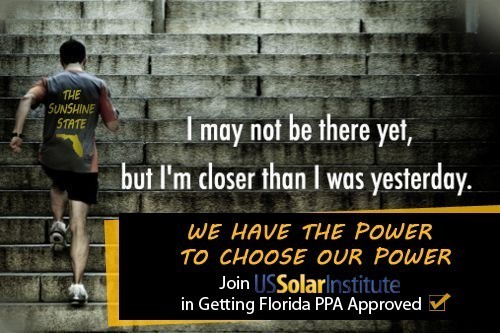Ah, the sunny south, the land of peaches, oranges and solar potential.
I’m talking about Georgia and Florida here, and the key word is “potential”, unless you just really like fruit salad. Both states rank very high on sun index research that ranks states based on the amount of high quality sunshine they get, yet both have faced major challenges in harnessing this potential and adopting solar energy as a power source in the state. Georgia has made tremendous progress in overcoming these challenges, with the most recent step being the Georgia Senate’s unanimous passing of House Bill 57 following the Georgia House’s unanimous passing in February. This piece of legislation allows for third party sale of solar power, a commerce-focused policy already in place in the majority of the country. [Third party sale of solar power is commonly referred to as a power purchasing agreement, or a PPA. You can learn more about how a PPA actually works in this short video explanation we made at US Solar Institute: What is a PPA?]
The timing of this legislation is interesting, given that Florida is currently trying to do the same thing – bring solar power to the Sunshine State through the legalization of PPA’s. If you look at the history of the Georgia and Florida, the oranges have followed in the peaches footsteps before; perhaps we will see this happen with PPA’s as well. I can’t help but think of a young kid taking after their slightly older sibling – they’re still both figuring out how to be cool, the younger one always a few steps behind the older.
It’s important to note that this recent Georgia legislation was not a free-for-all green light for solar. Residential PPA’s are limited to 10 kilowatts and commercial PPA’s are limited to 100 kilowatts. These restrictions and regulations are hardly surprising given the often-repeated rhetoric from Georgia utility companies about the costly burden that solar will place on “the rest of us”. Setting aside the cost of NOT going solar, some might call that rhetoric nothing but un-founded fear mongering from monopolies at risk of losing their profits, but I’ll let you draw your own conclusions.
Regardless of personal and corporate economics and opinions, PPA’s are a financing mechanism designed to give consumers more choices about where they get their power from. The fact that the Georgia Legislature has passed this bill, and that their governor intends to sign it, means that there will now only be FOUR states in which PPA’s are not allowed: Kentucky, North Carolina, Oklahoma, and Florida, the ever-ironic Sunshine State.
This is not a cool club to be in.
Current efforts in the state of Florida are gaining momentum to join Georgia and the rest of the country. The Floridians for Solar Choice, along with a wide range of bi-partisan political and non-political groups, organizations, and volunteers, are championing a petition to put a measure on the 2016 November ballot that, if passed, would allow for PPA’s in Florida. The petition initiative has passed the important first milestone of collecting over 70,000 signatures. A minimum of 68,000 was needed to get the measure reviewed by the Florida Supreme Court. These signatures were collected in an astonishingly short time period – less than two months – and represent the incredible demand for solar that is currently not being met in the state of Florida.
Production restrictions or not, the solar news out of Georgia, alongside the progress that Florida petition initiative is making, are steps in the right direction. It is important that this momentum and progress continues. If you are a registered Florida voter, I encourage you to get involved in the petition initiative yourself! US Solar Institute is proud to be a volunteer center for South Florida and welcomes your questions and participation! You can email us at info@ussolarinstitute.com, and we’ll be happy to send you more information on how you can get involved. If you are not located in South Florida, you can also check out Floridians for Solar Choice to find volunteer centers close to you!

